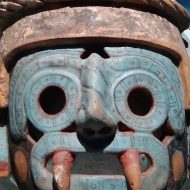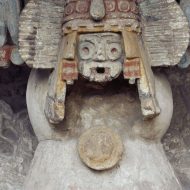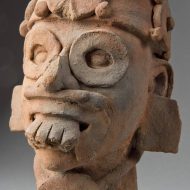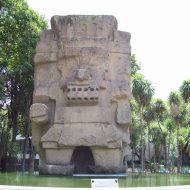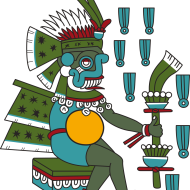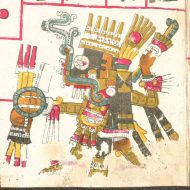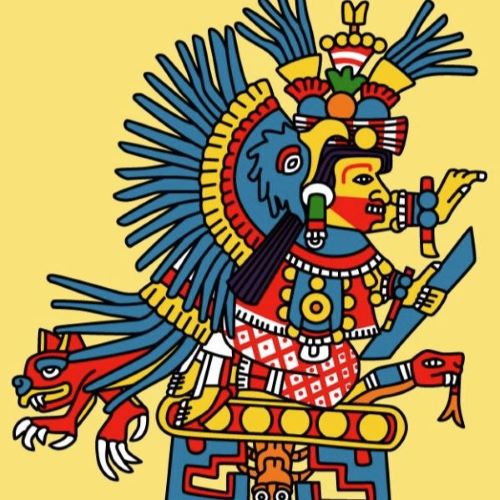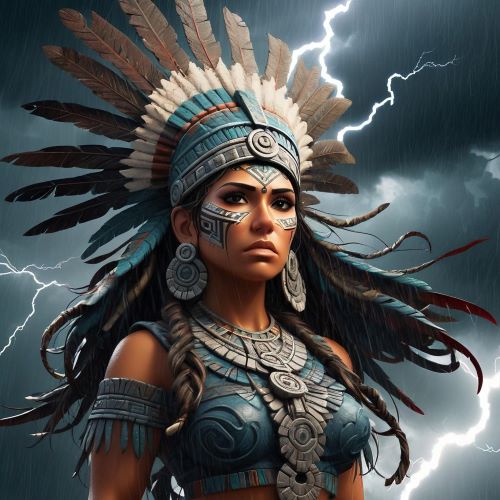Tlaloc : The Thunder God
Listen
At a glance
| Description | |
|---|---|
| Origin | Aztec Mythology |
| Classification | Gods |
| Family Members | Chalchiuhtlicue (Wife), Tecciztecatl (Son) |
| Region | Mexico |
| Associated With | Lightning, Thunder, Rain, Drought, Human Sacrifice |
Tlaloc
Introduction
The Aztec deity known as Tlaloc is regarded as the god of rain, water, and agriculture. He was also a fearsome and powerful deity who frequently caused severe droughts and storms to express his displeasure. He was regarded as a benevolent deity who provided much-needed nourishment, but he was also an unpredictable and cruel one who sent storms, lightning and drought.
In the Aztec Creation myth, Tlaloc was the ruler of the 3rd Sun. He was also linked to the deer known as Mzatl, and he was regarded as one of the most significant figures in the Lord of the Night and the Lords of the Day. The origins of the god are probably much earlier as he shares many similarities with the Olmec God IV and the Mayan God B or Chac.
Tlaloc was created during the creation phase after Huitzilpochtli and Quetzalcoatl dismembered a reptilian creature known as Cipactli. He was often associated with various weather conditions such as storms, floods, ice, and rain.
Physical Traits
In Aztec art, Tlaloc is usually depicted with a pair of googly eyes which was distinctive to him and a pair of fangs. He was also often accompanied by water, maize, and lightning in all depictions. In Tenochtitlan, offerings made to Tlaloc included the skulls of various animals such as the jaguar, which were considered to be the ultimate sacrifice.
As a deity, Tlaloc was represented by the distinctive features of his statue, such as his mask and his headdress, which are made of feathers of the heron. He was also known to carry various objects, such as a ritual water container, a bolt of lightning or a cornstalk.
Family
Although most Aztec gods had traditional parents, Tlaloc and his wife, Chalchiuhtlicue, were created by the multiple offspring of Ometecuhtli and Omecihuatl who were Xipe Totec, Tezcatlipoca, Quetzalcoatl, and Huitzilopochtli. Tlaloc’s son, Tecciztecatl, was created after he followed the god Nanahuitzin into a bonfire to create the fifth sun. Some stories claim that Tlaloc married Xochiquetzal, whose name was Flower Quetzal Feather. However, she was stolen by Tezcatlipoma after which Tlaloc married another rain goddess.
Other Names
In the various Mesoamerican cultures Tláloc appears as Dzahui for the Mixtec, Tajίn for the Totonac, Chupithripeme for the Tarascan and Cocijo for the Zapotec. Tlaloc was also associated with the dead and with the Earth. His name is believed to have come from the Nahuatl word tllli, which literally means “the path beneath the earth.” It has also been interpreted as a long cave, a deity who is made of earth, and a man who is the epitome of the planet. Other names of Tlaloc were Tlamacazqui (“Giver”) and Xoxouhqui (“Green One”); and (among the contemporary Nahua of Veracruz), Chaneco.
Powers and Abilities
Besides being regarded as a powerful deity, Tlaloc was also greatly feared by the Aztecs. He could cause severe droughts and storms to provoke hunger and death, and he was known to throw lightning upon the Earth and unleash powerful hurricanes. According to some, he could also send down various types of rain, which could destroy crops or affect various other areas of the Earth.
Some of the common illnesses that were attributed to Tlaloc and his fellow deities, such as rheumatism, dropsy, and leprosy, were also said to have been caused by him and his companions. Although the dead were usually cremated, those who had died due to one of these illnesses or were struck by lightning were buried. Tlaloc, however, fulfilled his promise to give the deceased an eternal life in his paradise.
Modern Day Influence
Many scholars believe that the various cultures of South and Meso America can be traced back to one common origin using Tlaloc as there are multiple gods with similar storylines and visual representation. This has also led to confusions arising to various non Tlaloc figures and representations being attributed to him. In the 1970s a temple dedicated to the god was built on top of Mount Tlaloc giving rise to the belief that a revival of worship and rituals are in place.
Related Images
Frequently Asked Questions
What is lorem Ipsum?
I am text block. Click edit button to change this text. Lorem ipsum dolor sit amet, consectetur adipiscing elit. Ut elit tellus, luctus nec ullamcorper mattis, pulvinar dapibus leo.
What is lorem Ipsum?
I am text block. Click edit button to change this text. Lorem ipsum dolor sit amet, consectetur adipiscing elit. Ut elit tellus, luctus nec ullamcorper mattis, pulvinar dapibus leo.
What is lorem Ipsum?
I am text block. Click edit button to change this text. Lorem ipsum dolor sit amet, consectetur adipiscing elit. Ut elit tellus, luctus nec ullamcorper mattis, pulvinar dapibus leo.
What is lorem Ipsum?
I am text block. Click edit button to change this text. Lorem ipsum dolor sit amet, consectetur adipiscing elit. Ut elit tellus, luctus nec ullamcorper mattis, pulvinar dapibus leo.
What is lorem Ipsum?
I am text block. Click edit button to change this text. Lorem ipsum dolor sit amet, consectetur adipiscing elit. Ut elit tellus, luctus nec ullamcorper mattis, pulvinar dapibus leo.

